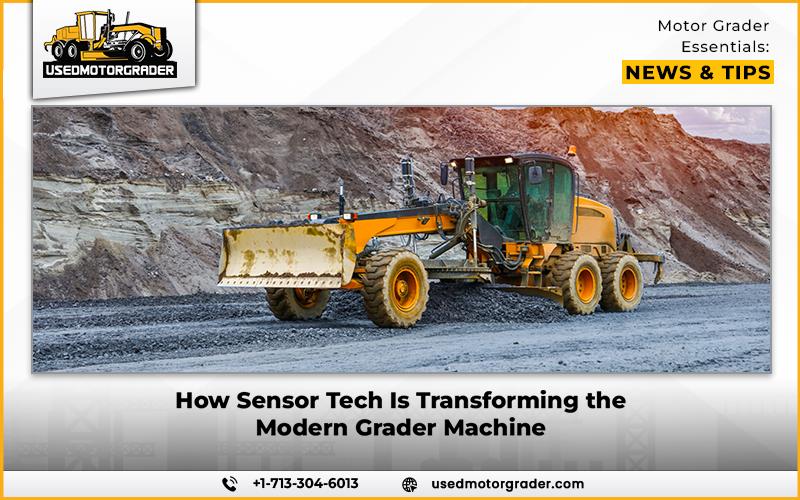The New Era of Precision Grading
Contractors and businesses have used grader machine models to deliver precise results for multiple decades. The long blades and movable frame of graders make smooth surfaces while fixing slope gradients and making the terrain even. The basic grading machine has developed into a more sophisticated system because today’s construction projects demand exact work and smaller error margins. The introduction of sensor technology makes grading depend on digital accuracy more than operator ability because it provides real-time data and automated feedback that helps operators work with confidence.
Why Precision Matters in Modern Grading
During infrastructure project operations, grading remains the biggest determining factor of success or failure. When builders make tiny errors with slope and surface heights these problems appear minor but produce significant problems during construction and operation. High-precision grading has become essential to modern construction projects because of stricter runway and road specifications. The project’s success depends on achieving accurate results before moving forward, while cutting down on unnecessary work and improving project flow through all stages.
The Rise of Real-Time Slope Monitoring Systems
Real-time slope monitoring systems now define how grader technology improves. The sensors placed on the blade and frame give precise readings of how the blade stands upright and leans side to side. The system lets operators see precise measurements of surface pitch and angle right after they make adjustments. The accurate sensors make sure grading stays steady across different terrain types and slope transitions which stops time delays from uneven surfaces.
Automatic Blade Control: Taking Human Guesswork Out of the Equation
The automatic blade control system reduces operator workload by taking over many of their tasks. Electronic blade controllers adjust the blade position to match real-time data, which lets operators work at their desired pace without manual control. Operators spend less time working and feel less tired because this system helps with faster grading. Sensors that control small adjustments allow the operator to pay attention to machine placement and safety. This advanced system uses technology effectively to save time and produce better results throughout the project life cycle.
Digital Terrain Modeling and Machine Guidance Integration
Digital terrain modeling (DTM) forms the basis of this new sensor technology. These digital maps show the grader both the terrain shape and how the finished design should look. The onboard system of the machine analyzes the design plan and controls the blade movements to create exact results. It’s like giving the grader machine a GPS map for the Earth itself through this system. Connecting DTM to sensors helps operators follow the project target better, which brings more efficiency and fewer human mistakes. Moving between different grading zones happens faster as the operator does not need to set physical targets.
Enhancing Collaboration with Connected Grader Systems
The latest development in grading machine technology includes the connection of different operating systems. Graders now join linked machines working on the same project to share live project data. When linked to other construction machines, graders share operational information with bulldozers, excavators, and dump trucks. Other machines attached to the network will automatically adjust their operations when the grader operator adjusts the slope or leveling at a specific spot. The connected machines share data better to save time and workloads while making sure each piece of equipment operates at peak performance. Connected systems give operators and managers real-time grading process data to support better project management decisions.
Maintenance and Calibration: Keeping Sensor Systems Sharp
The presence of advanced technology changes how service tasks must be performed. Sensors need regular adjustments to stay precise because long travels and heavy work affect their performance. System updates require similar management methods as digital systems, and diagnostic tools help monitor electronic health on board vehicles. Modern grading systems with built-in checks in new grader machine models help operators and mechanics identify potential problems during their work. Small sensor problems are stopped from developing into major system failures by this system, which maintains steady grading performance.
How Sensor Tech Is Bridging Skill Gaps
New operators can learn grading operations better through sensor technology because experienced drivers continue to provide valuable expertise. The new operator can perform operations expertly sooner, thanks to guided interface tools and visual quality indicators, along with voice guidance. The technology assists both operators who need to hurry and locations with limited skilled workers. The grading system transforms into a learning assistant that helps operators become better at their job and prevents mishaps. Digital interfaces that understand human actions make it possible for entry-level personnel to achieve professional results.
What’s Next for Sensor-Driven Graders?
The path of grading machines leads directly toward digitization. With advanced technology entering construction, the grading systems will evolve to understand terrain types and react to soil conditions while working from remote locations. Graders that work without human control will likely become operational in mine sites and other remote locations. The initial slope sensors and blade control system have evolved into a complete intelligent machine control system. Through these machines, construction companies gain faster results and precise work, plus machines that understand and handle ground conditions.


